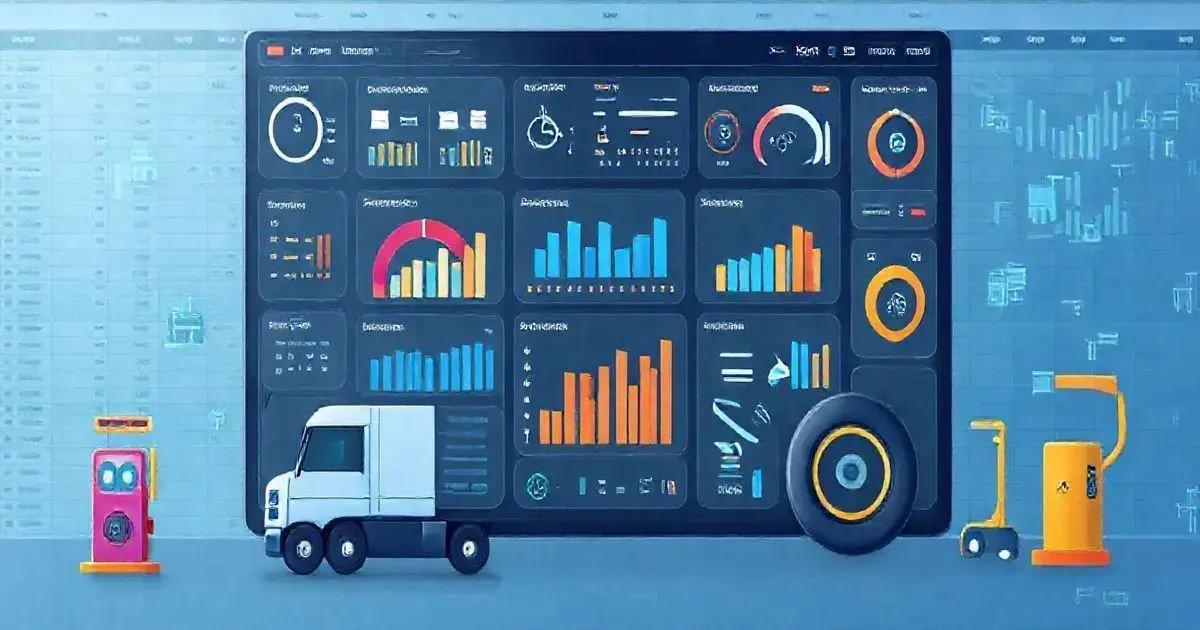Unlocking Efficiency: Fleet Control Worksheet 7.0 Leave a comment
The Fleet Control Worksheet 7.0 is a vital tool for fleet management, offering features such as dashboards for tracking kilometers driven, fuel efficiency, tire maintenance, and vehicle registration management. It helps ensure vehicle maintenance, compliance, and operational efficiency, ultimately reducing costs and enhancing safety for organizations.
The Fleet Control Worksheet 7.0 is a comprehensive tool specifically designed for optimizing fleet management. This spreadsheet allows you to easily track vehicle usage, maintenance schedules, and even fuel consumption, all in one place. With features like initial dashboards and tire control, it empowers fleet managers to keep operations running smoothly.
Initial Dashboards Overview
The Initial Dashboards in the Fleet Control Worksheet 7.0 provide a vital overview to fleet managers, showcasing key metrics at a glance. These dashboards are designed to simplify data interpretation and enable quicker decision-making. Here’s a breakdown of some of the main components:
- KM by Driver: This section displays the total kilometers driven by each driver, helping to monitor performance and identify any discrepancies in driving habits.
- KM per Vehicle: This allows you to track the mileage of individual vehicles, making it easier to assess vehicle usage and determine if any are under or overused.
- KM per Liter: Understanding fuel efficiency is crucial. This metric informs managers of how many kilometers each vehicle can travel per liter of fuel, aiding in budgeting and cost management.
- KM per Trip: This feature helps analyze the distance covered for each trip, which can assist in understanding route efficiency and planning future journeys.
- Average Consumption per Vehicle: By calculating the average fuel consumption for each vehicle, managers can identify which vehicles may require maintenance or are less fuel-efficient.
- Average Consumption per Driver: This metric provides insights into each driver’s fuel efficiency, enabling targeted training or adjustments in driving behavior.
- Total General Maintenance: Keeping track of all maintenance costs allows for better budget management and planning for future repairs or upgrades.
- Maintenance Cost Average: This shows the average expenditure on maintenance per vehicle, helping to forecast future maintenance budgets.
- Total Cost of Mechanical and Electrical Maintenance: This section summarizes the total spent on mechanical and electrical repairs, providing a clear picture of operational costs.
- Total Tire Maintenance Cost: Understanding how much is spent on tire maintenance helps in budgeting for replacements and ensuring that all tires are in good condition to avoid accidents.
- Total Lubricant Cost: Keep an eye on lubrication expenditures to ensure that vehicles are properly maintained, which can save costs in the long run.
- Vehicles in Transit: This feature tracks which vehicles are currently engaged in transit, allowing for effective fleet management and logistical planning.
- Tires in Transit: Monitoring the status of tires in use helps ensure that replacements are made timely to maintain safety standards.
- Delayed Vehicle Documents: This section flags any vehicles with outstanding documentation issues, helping to avoid legal complications.
- Delayed Driver Documents: Similarly, it helps keep track of drivers who need to update their documents, ensuring compliance with regulations.
- Delayed Preventive Maintenance: Tracking overdue maintenance helps avoid unnecessary breakdowns and prolong the lifespan of the fleet.
- Total Cost Versus Shipping: This metric compares overall shipping costs against vehicle maintenance costs, helping to gauge the profitability of operations.
- Fuel, Maintenance, and Other Costs: By integrating all operational costs into one dashboard, fleet managers can make informed financial decisions regarding their fleet.
By utilizing the Initial Dashboards of the Fleet Control Worksheet 7.0, fleet managers can gain actionable insights into their operations, paving the way for effective management and optimized performance.

Travel and Cargo Control Features
The Travel and Cargo Control Features of the Fleet Control Worksheet 7.0 are essential for managing logistics effectively. These features facilitate the seamless tracking of trips, cargo, and all related expenses. Here’s an overview of what you can expect:
Cargo Control Linked to Trips: This feature allows fleet managers to link specific cargo loads to individual trips. By tracking which cargo is on which trip, managers can ensure accountability and traceability, and plan efficiently for future shipments.
Vehicle Control: It’s crucial to maintain a record of which vehicles are assigned to particular trips. This feature not only helps in allocating resources effectively but also aids in assessing vehicle performance over time.
Driver Control: Similar to vehicle control, this feature tracks which drivers are assigned to each trip. By managing driver assignments, fleet managers can monitor driving hours, ensure legal compliance regarding working hours, and optimize route assignments based on driver experience.
Supply Control: Keeping track of supplies needed for each trip ensures that vehicles are adequately stocked. This feature helps prevent delays caused by missing supplies and supports efficient operations.
Control of All Travel Expenses: This feature provides a comprehensive overview of all expenses incurred during travel, including fuel, tolls, and other operational costs. By maintaining detailed records, fleet managers can analyze costs and make informed financial decisions.
By leveraging these features in the Fleet Control Worksheet 7.0, fleet managers can significantly enhance their logistical operations, ensuring that every journey is well-planned and efficiently executed.
Tire Maintenance Tracking
The Tire Maintenance Tracking feature within the Fleet Control Worksheet 7.0 is a critical component for ensuring the safety and efficiency of your fleet. Proper tire management not only extends the life of the tires but also promotes fuel efficiency and enhances vehicle safety. Here’s what this feature covers:
Identification for Each Tire: Each tire is assigned a unique identifier that allows fleet managers to track its history, including installation dates, mileage usage, and maintenance records. This identification system helps in managing replacements and servicing efficiently.
Tire Change Schedule by KM: This aspect of the tracking feature provides a maintenance schedule based on cumulative kilometers driven. It notifies managers when tires are due for rotation or replacement, helping to prevent premature wear.
Signal of How Much KM is Left to Change the Tire: By analyzing the remaining tread depth and current mileage, this feature calculates and signals the kilometers left before a tire should be replaced. This proactive approach ensures that tires are changed before they reach an unsafe condition.
Status per Action: The status tracking feature allows managers to monitor actions taken on each tire, such as allocation to a vehicle, removal from service, scrapping, or maintenance. This transparency helps optimize tire utilization and management decisions.
With the Tire Maintenance Tracking feature in the Fleet Control Worksheet 7.0, fleet managers can keep their vehicles safe and efficient, significantly reducing the risk of tire-related incidents and fostering a culture of proactive maintenance.

Preventive and Corrective Maintenance
The Preventive and Corrective Maintenance feature of the Fleet Control Worksheet 7.0 is essential for maintaining the operational integrity of your fleet. This feature allows fleet managers to meticulously plan and track all maintenance activities, ensuring that vehicles remain in optimal condition. Here’s a closer look at what this feature encompasses:
Corrective Maintenance Type: This section categorizes the types of corrective maintenance performed on each vehicle, helping managers to understand the most common issues faced. By identifying recurring problems, managers can take steps to mitigate these issues proactively.
Maintenance by Vehicle: Keeping detailed records of maintenance tasks performed on each vehicle allows managers to track the vehicle’s history and evaluate its overall health. This feature helps in identifying patterns that may signal impending failures, allowing for timely interventions.
Maintenance by Mechanical and Electrical Type, Tire and Lubricants: This component breaks down maintenance tasks by category, providing insights into specific areas that may need more focus. By examining mechanical, electrical, tire, and lubricant maintenance separately, fleet managers can optimize their maintenance schedules and budgets.
Maintenance Cost: Understanding the costs associated with maintenance helps managers budget effectively and make informed financial decisions. This feature consolidates all costs related to maintenance activities, providing a clear picture of expenses incurred over time.
Preventive Maintenance Schedule: This function helps ensure that all vehicles are serviced regularly based on predetermined schedules. By adhering to a preventive maintenance schedule, fleet managers can reduce the likelihood of unexpected breakdowns and prolong the life of their vehicles.
Preventive Maintenance Signal: This alert system notifies managers when preventive maintenance is due, ensuring that vehicles receive necessary servicing on time. Regular maintenance checks can lead to improved vehicle reliability and reduced total cost of ownership.
Status by: Scheduled, Accomplished, and Delayed: This tracking feature allows fleet managers to monitor the status of all maintenance tasks, categorizing them into scheduled, completed, or overdue. This visibility ensures that nothing falls through the cracks and that all vehicles are maintained according to plan.
By effectively utilizing the Preventive and Corrective Maintenance feature in the Fleet Control Worksheet 7.0, fleet managers can optimize their maintenance operations, enhance vehicle longevity, and ultimately reduce costs associated with repairs and downtime.
Vehicle Registration Management
The Vehicle Registration Management feature in the Fleet Control Worksheet 7.0 plays a crucial role in maintaining an organized and compliant fleet. Proper management of vehicle registrations ensures that all vehicles are legally authorized for operation and helps avoid any potential fines or legal issues. Here’s an overview of what this feature includes:
Driver Registration: This section allows fleet managers to keep detailed records of all drivers associated with the fleet. Each driver’s personal information, license details, and certifications can be stored, making it easy to verify compliance with legal and safety regulations.
Vehicle Type Registration: Managers can categorize vehicles based on their types—such as trucks, vans, or SUVs. This classification aids in managing different maintenance schedules, insurance requirements, and operational needs based on vehicle type.
Mechanical and Electrical Services Registry: This registry keeps track of all mechanical and electrical services performed on each vehicle. By maintaining a detailed history, fleet managers can monitor vehicle performance and address any mechanical issues promptly.
Tree Service Registration: This feature allows for the registration of service information regarding tree services, which might include maintenance and inspection logs. This tracking ensures that any specialized vehicles receive the attention they require based on their specific operational needs.
Lubricant Services Register: Keeping a record of lubricant services is essential for vehicle maintenance. This register helps track when and how often lubricants are used, ensuring that vehicles operate smoothly and efficiently.
Register of Workshops and Suppliers: This section enables fleet managers to maintain a list of authorized workshops and suppliers for vehicle repairs and parts. Having this information readily available facilitates quicker decision-making and ensures that all maintenance work is performed by trusted professionals.
Expenditure Type Register: By categorizing expenditures related to vehicle operations, fleet managers can analyze costs effectively. This register helps identify trends and areas where expenses can be reduced, improving overall budget management.
Refueling Station Registration: Keeping track of preferred refueling stations ensures cost-effective fuel management. It also helps monitor fuel expenditure and identify opportunities for savings.
Fuel Type Register: This register tracks the types of fuel used for each vehicle. By managing fuel type preferences, fleet managers can optimize fuel efficiency and ensure compatibility with vehicles.
By effectively utilizing the Vehicle Registration Management feature in the Fleet Control Worksheet 7.0, fleet managers can maintain compliance, optimize operations, and ensure that their fleet is always road-ready.

Document Control and Management
The Document Control and Management feature within the Fleet Control Worksheet 7.0 is essential for maintaining all necessary documentation related to vehicles and drivers.
Organized documentation not only ensures compliance with legal requirements but also streamlines operations. Here’s a breakdown of this feature:
- Driver Document Control: This section facilitates the tracking and management of all documents associated with drivers, including licenses, certifications, and training records. By keeping these documents up to date, fleet managers can avoid legal complications and ensure that drivers are adequately qualified.
- Vehicle Document Control: Similar to driver documents, this component helps manage all paperwork related to each vehicle in the fleet. This includes registration papers, insurance documents, and inspection certificates. Keeping this information organized is crucial for compliance and for maintaining the vehicle’s operational status.
By effectively utilizing the Document Control and Management feature in the Fleet Control Worksheet 7.0, fleet managers can ensure that all documentation is in order, which aids in maintaining compliance with regulations and reduces the risk of fines or legal issues.
Conclusion
The Fleet Control Worksheet 7.0 is an invaluable tool for fleet managers, providing comprehensive features that enhance operational efficiency and ensure effective management of vehicles and drivers.
From initial dashboards that offer key insights at a glance to meticulous tracking of tire maintenance, preventive and corrective maintenance, and thorough document management, this worksheet empowers managers to make informed decisions.
By leveraging the capabilities of the Fleet Control Worksheet, organizations can optimize their fleet operations, reduce costs, and improve safety standards.
Properly managing every aspect of fleet control not only contributes to smoother daily operations but also supports long-term success in a competitive market.
Investing in a structured approach to fleet management through this worksheet can yield significant returns, making it an essential resource for any organization looking to enhance its logistics and operational strategies.
FAQ – Frequently Asked Questions about Fleet Control Worksheet 7.0
What is the Fleet Control Worksheet 7.0?
The Fleet Control Worksheet 7.0 is a comprehensive spreadsheet designed to help fleet managers track and manage various aspects of fleet operations, including vehicle usage, maintenance schedules, and document management.
How can the worksheet help in tire maintenance?
The worksheet features tire maintenance tracking that allows managers to monitor tire identification, change schedules, and remaining mileage for tire replacements, ensuring safety and efficiency.
What types of maintenance can be tracked?
The worksheet allows tracking of both preventive and corrective maintenance types, along with costs associated with each vehicle, helping to keep the fleet in optimal condition.
Can I manage driver documents with this worksheet?
Yes! The worksheet includes a document control feature that helps manage and track all necessary driver documents such as licenses and certifications.
Is the worksheet suitable for all fleet sizes?
Absolutely! The Fleet Control Worksheet 7.0 is designed for flexibility and can be used for small, medium, or large fleets, making it a versatile solution for various organizations.
Do I need special software to use the Fleet Control Worksheet?
No, the worksheet works on any version of Microsoft Excel (2007 and later), making it accessible and easy to use without any additional software requirements.

